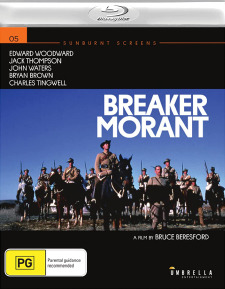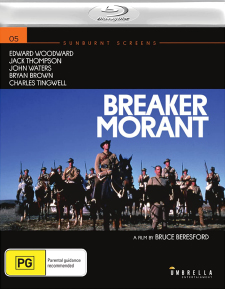Breaker Morant (Blu-ray Review)

Director
Bruce BeresfordRelease Date(s)
1980 (July 7, 2021)Studio(s)
Roadshow Film Distributors (Umbrella Entertainment)- Film/Program Grade: A
- Video Grade: B+
- Audio Grade: B
- Extras Grade: A-
Review
Director Bruce Beresford’s 1980 film Breaker Morant, along with Peter Weir’s Gallipoli the following year, were both landmark examinations of the indifferent treatment of Australian soldiers who served the British military. Breaker Morant takes place in 1902 during the Second Boer War. Harry “Breaker” Morant (Edward Woodward), Peter Handcock (Bryan Brown), and George Whitton (Lewis Fitz-Gerald) are Australian soldiers operating under British command in South Africa. When they’re accused of murdering Boer prisoners as well as a German missionary, they face court-marital by the British. They’re defended by Major J.F. Thomas (Jack Thompson), who fights to prove that they were following standing orders, even though it becomes clear that the British has no intentions of giving them a fair trial. While the verdict may have been a fait accompli, the trial itself was significant as it would prove to be the final time that the Australian Army would allow their own men to be prosecuted by the British.
Since the actual transcripts of the trial were destroyed, the screenplay by Jonathan Hardy, David Stevens, and Beresford was based on the play by Kenneth Ross, with additional material from The Breaker by Kit Denton. While the story bears a superficial resemblance to Stanley Kubrick’s Paths of Glory, the particulars are quite different. In Kubrick’s film, the defendants were chosen at random as scapegoats to cover up the failures of their commanding officers. Breaker Morant is far more ambiguous, and it never disputes the fact that Morant, Handcock, and Whitton were indeed responsible for the killings. What’s at question in the film is whether they were following orders, and whether or not that provided a valid excuse for their actions. It shows the inherent paradox of holding murder trials during wartime—there’s an argument to be made that the men were morally wrong, yet they weren’t condemned on moral grounds, but rather military ones. Ironically, they ended up being acquitted of the one charge where two of them may have been the most clearly guilty, while being condemned for the debatable matter of following orders. Beresford had this to say on the matter: “The film never pretended for a moment that they weren't guilty. It said they were guilty. But what was interesting about it was that it analyzed why men in this situation would behave as they had never behaved before in their lives. It's the pressures that are put to bear on people in war time.” Morant himself summed up the contradictions of military service in the final poem that he wrote in his prison cell:
But we bequeath a parting tip
For sound advice of such men,
Who come across in transport ship
To polish off the Dutchmen!
If you encounter any Boers
You really must not loot 'em!
And if you wish to leave these shores,
For pity's sake, DON'T SHOOT 'EM!!
Breaker Morant was shot on 35 mm film by cinematographer Donald McAlpine using Panavision Panaflex cameras with Panavision spherical lenses, framed at 1.85:1. Umbrella Entertainment’s Sunburnt Screens edition (number five in the series) doesn’t appear to use the same master as Criterion’s 2015 release, as there’s minor damage visible throughout, mostly in the form of light speckling. It’s also just a bit softer at times. Criterion’s version came from a 4K scan of the original negative, but this may have been from a secondary source like an interpositive. It looks solid, though, with good colors, natural flesh tones, and decent contrast—it’s just not as sharp or as clean.
Audio is offered in English 5.1 DTS-HD Master Audio, as well as the original English mono in 2.0 DTS-HD Master Audio, with optional English subtitles. There’s not much difference between the two tracks. The 5.1 version adds some reverberation to make it sound fuller, but it’s still effectively a mono track with a little more spaciousness. Both tracks sound clean, with decent dynamics and clear dialogue.
The following extras are included:
- Audio Commentary with Bruce Beresford, Bryan Brown, and Matt Carroll
- Breaker Morant: The Retrial (HD – 92:41)
- Edward Woodward Audio Interview (HD – 20:06)
- The Breaker (Upscaled HD – 54:49)
- The Myth Exposed (HD – 5:56)
- Photo Slideshow (HD – 43 in all – 5:29)
- Photo Gallery (HD – 51 in all – 5:51)
- Trailer (HD – 3:06)
- US Trailer (HD – 2:31)
The newly recorded commentary track for this edition features director Bruce Beresford, actor Bryan Brown, and producer Matt Carroll reminiscing about making the film. They discuss the background for the production, how the story was developed, and the decision to use the non-Australian Edward Woodward as the lead. They also cover the locations, McAlpine’s cinematography, and the differences between Breaker Morant and Paths of Glory. The trio have an easygoing style with each other, though there are a few gaps later on, especially when they get caught up in Jack Thompson’s courtroom speeches. They also don’t identify themselves anywhere on the track, so sorting them out can be a little difficult at first. Breaker Morant: The Retrial is a 2013 Australian feature-length documentary directed by Gregory Miller and Nick Bleszynski. It’s a comprehensive look at the historical figure of Morant, the specifics of the Boer War, the trial, and its aftermath, as well as modern-day attempts to clear the names of the condemned. Featuring interviews with experts as well as the descendants of those involved—including the Boers—it’s a balanced look at the complexities involved in the case. The audio only interview with Edward Woodward was conducted in 1980, and it covers the character of Morant, the historical context, the reception that the film received, and Jack Thompson’s Supporting Actor award at the Cannes film festival. The Breaker is a 1974 documentary about Morant which was directed by Frank Shields. It provides even more details about Morant’s life, including stories about his horse-breaking skills and his military service. Shields funded the film himself for $7,000, and admitted that he had no idea how to operate a camera, so the project became his film school. He was rewarded when it won Best Documentary at the 1975 Sydney Film Festival. The Myth Exposed features Shields in 2011 showing one piece of evidence which he had omitted from his film: a 1929 letter from Whitton to Thomas in which Whitton clearly implicated Morant and Handcock in the murder of the German missionary.
Not included from the Criterion Collection Blu-ray is the original Bruce Beresford solo commentary; interviews with Beresford, Donald McAlpine, Bryan Brown, and Edward Woodward; and the program on the South African war.
While Breaker Morant wasn’t particularly successful outside of Australia in 1980, it still brought Beresford international acclaim—a few years later, he noted: “I have a feeling it doesn't really matter what other films I make, I'll always be introduced as Bruce Beresford who made Breaker Morant.” Beresford has directed plenty of other notable films in the decades since then such as Tender Mercies and the Academy Award-winning Driving Miss Daisy, but even if he was still only remembered for Breaker Morant, that would be enough.
- Stephen Bjork
(You can follow Stephen on Facebook at this link)

